17. Old man eats food in Babette’s Feast

It may seem odd that the sight of an old man eating food would top other scenes on this list or even end up here at all. But Gabriel Axel manged to find existential ponderings within a simple meal in his film about the story of a mysterious French woman Babette (Stephanie Audran) who is taken in by two elderly spinster sisters in 1871.
Over the years, an unlikely bond grows between the Frenchwoman, who works as their housemaid, and her pious, yet kindly benefactors. When Babette wins the lottery she resolves to cook a fabulous feast for the stubborn villagers. By agreeing, the sisters risk the wrath of their puritanical fellow parishioners.
When one patron tries the meal consisting of foie gras, turtle soup, quail stuffed with truffles, followed by baba au rhum memories are stirred and he finds himself revaluating his long and prolific life.
It’s an oddly powerful scene and runs the risk of being hard to swallow but Jar Kulle’s dignified and restrained performance brings legitimacy and levity to the situation as well as emotional weight and quiet contemplation.
16. I am Your Father in The Empire Strikes Back
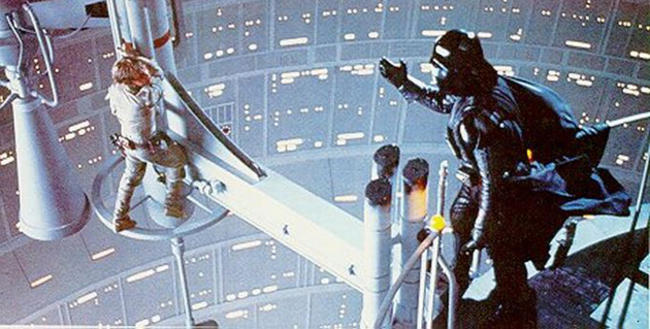
Essentially everyone who is old enough to have witnessed this moment for the first time has a story to tell of how shocked they were, how they went into denial or how they immediately started to generate their own theories as to what would happen next.
For a certain generation their cinematic lives are defined and forged in this moment, when an entire world of expectations and assumptions is completely turned on its head in the best possible way.
When the villainous Darth Vader is revealed to be the father of Luke Skywalker as opposed to what we had been led to believe which is that Vader betrayed and murdered Luke’s father it crated seismic shock waves both within the story of Star Wars itself and the rest of the world that watched it.
It is hard to imagine such a twist for such a major picture being kept secret today, even back then it was a struggle with alternative scripts and reshoots that kept everyone other than George Lucas, Mark Hamill and James Earl Jones.
The rumour is that when it came for David Prowse to say the line on set he was given the line “Obi Wan killed your father” which everyone on set agreed was a satisfying twist. But of course Lucas went a step further and dropped a bombshell that no one was expecting, dubbing over the actual line with James Earl Jones.
Immediately after the recording session Jones marched over to Lucas’ office and demanded to know if Vader really was telling the truth. Not enough credit goes to Mark Hamill whose cries of anguish and shocked expression really sold the scene and forever cemented it into our memories.
15. A Great Murder Story in Crimes and Misdemeanors
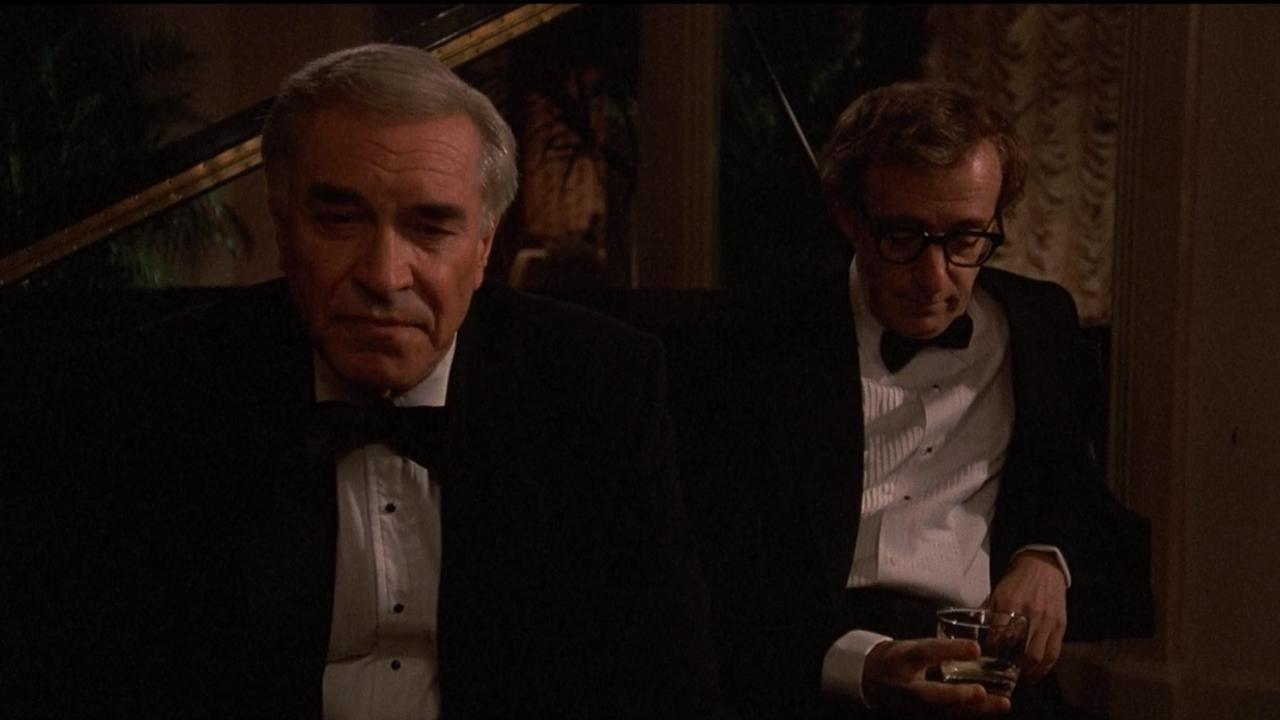
The final scene of Woody Allen’s Crimes and Misdemeanors brings together its two story threads that have been studied and examined throughout the film.
One follows the exploits of a philandering optometrist (Martin Landau) who is trying hard to break off his relationship with an obsessive, overly dependent woman (Angelica Huston) who blackmails him into remaining with her. Her conniving leads to tragedy. The other plotline deals with a depressive documentary maker (Allen) in love with his producer (Mia Farrow).
When the two stories converge Landau and Allen end up sat together and Allen divulges that he is “plotting the perfect murder” only for Landau to reply that he has “a great murder story”.
There’s a certain satisfaction in seeing both characters skirt around their true identities and try to relate it to another person, as the intense close up focuses on Landau’s strained confession of guilt we get to see every inch of the stress and guilt that plagues him.
Of course the fact that we have already seen this unfold makes it all the more interesting to hear his recount of it, and all the more ironic when the camera pans around to see Allen treating it as one would any random story.
We know this one is actually real and not just a hypothetical quandary. Both actors give terrific performances and it’s all captured under Sven Nykvist’s stunning cinematography, making it a scene to remember.
14. Not Yet Kameraden in Das Boot
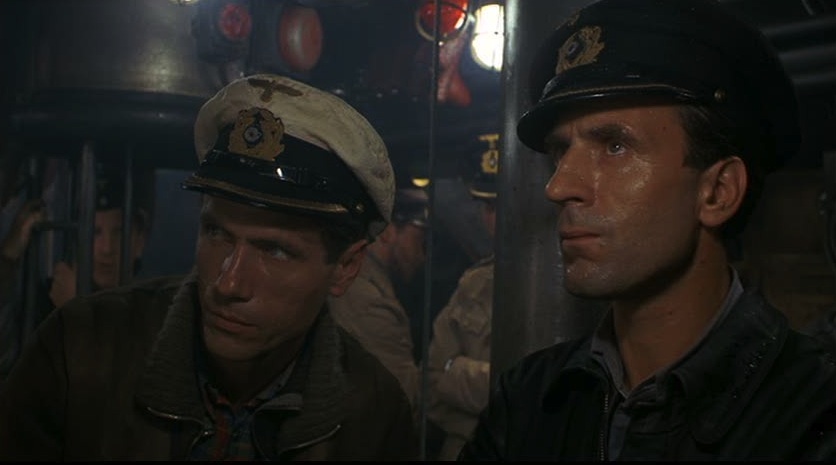
Frequently viewed as one of the greatest war movies of all time Das Boot is, despite its claustrophobic setting, an epic in every sense of the word.
A film that not only offer thrilling and frighteningly tense sequences but also offers a philosophical insight into the lives of each soldier within the damaged U-Boat. It depicts both the excitement of battle, the fear of death and the tedium of war itself from the perspective of the seemingly insignificant soldiers.
One of the film’s final scenes is the perfect example of all of these elements. Having sunk to the ocean floor the crew have been forced to make numerous repairs before running out of oxygen.
After over 16 hours, they are able to surface by blowing out their ballast of water, and limp back towards La Rochelle under cover of darkness. The tension that Wolfgang Peterson is able to build, combined with the sheer elation of finally re surfacing is unparalleled.
He employs numerous dramatic tools such as utilising the closed and claustrophobic environment of the submarine, creating an off kilter atmosphere through his unique use of varying camera angles and focusing on each technical detail, making the audience attentive to the first sign of trouble.
Then the concerned and fearful expression of each soldier only adds to the conviction of just how dangerous the situation is. It’s a masterful example of tension that stands as the highlight of an already spectacular film.
13. Meeting the Drill Instructor in Full Metal Jacket

Stanley Kubrick’s unconventional but undoubtedly harrowing war drama spends is divided into two parts, the second is to demonstrate the futility and pointlessness of war.
The first is to display the dehumanisation of the soldier as he is robbed of identity, dignity and mercy. All of that can be seen upon meeting the films iconic drill instructor Gunnery Sergeant Hartman, played by R Lee Ermey.
Contrary to a popular myth Full Metal Jacket was in fact not Erney’s, a tried and trained marine instructor, first role. He got that in Apocalypse Now as a helicopter pilot and then in Boys in Company Sea before finally arriving at the role that would define the rest of his career.
Rumours state that Kubrick asked the actor to send him a list of creative insults before casting him, as well as the audition tape that had already been sent. Even after that Erney improvised most of his dialogue and the first scene may be the most astonishing display of that.
As we said earlier the first half of Full Metal Jacket chronicles the dehumanisation process that the soldiers went through and Hartman is instrumental to that. He spits, insults, curses and humiliates the recruits with frightening yet magnetic energy.
The way in which he deconstructs them, casually orders them to adopt the names he assigns them and even physically beat them is not only an explosive display of acting talent but it also lends itself to the deeper themes of the entire movie and that is what a great scene should do.
12. Say hello to my little friend in Scarface
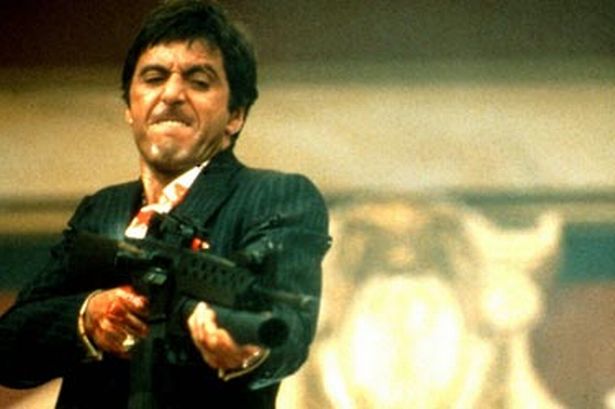
Brian De Palma has directed many astonishing sequences in his career from the stairway shootout in The Untouchables to the prom queen scene from Carrie but perhaps his crowning achievement is this explosive finale to his epic crime drama, Scarface.
Chronicling the rise and fall of Cuban drug lord Tony Montana who is played in a brilliantly over the top manner by Al Pacino and this scene may be the culmination of that performance as well as the entire movie as his empire lies in tatters, his family torn askew and rival gang soldiers invading his compound, Tony makes his final stand.
The scene starts with Pacino’s iconic scream of “Say hello to my little friend”. That little friend is in fact an M-16 assault rifle with a 40 mm grenade launcher built in and while filming Pacino accidentally grabbed the muzzle of the weapon after firing a dozen shots and badly burnt his hand, despite being filled with blanks.
On a technical level the scene is much more sophisticated than one would think, with each gun being electronically synchronised with the camera shutter to capture each muzzle flash. Another bit of trivia is that Steven Spielberg was visiting the set during production and was allowed to direct a single shot of the scene.
It is pure and unrestrained carnage, complete with multiple explosions a high body count and a fantastically stylised aesthetic that only De Palma could do, making it massive, enthralling and iconic.
11. Attack on Third Castle in Ran

Akira Kurosawa’s last great epic was quite possibly his most daring and ambitious project of all and nowhere is that more apparent than the astonishing Attack on the Third Castle.
Depicting an aging warlord who decides to abdicate and divides up his kingdom between his three sons we can only watch in horror as the kingdom tears itself apart. In one massive military stroke two of the warlord’s sons forge an alliance and launch an attack on his place of refuge in an attempt to ensure their own authority.
The battle scene is incredible to behold, filled with striking images and a strong use of colour is as beautiful as it is destructive. Kurosawa’s distinctive direction is at its best when capturing action on a large scale and this scene stands as one of the finest examples of that. It is at once chaotic and terrifying while also being visually stunning and breath taking in its scale.
Credit also goes to the costume department who won an Academy Award for their efforts. It is easy to see why Ran was the most expensive Japanese film ever made upon its release.
The scene also balances all of the central themes of the movie from chaos to nihilism and warfare. But for all of the grandeur and style Kurosawa never forgets to focus on the more intimate aspects of his story, we see the shock and horror as entire lives are obliterated in one terrible and formidable swoop.
We witness the destruction first-hand and with the Kurosawa’s use of pathetic fallacy as approaching cumulonimbus clouds break into a raging storm during the massacre.
10. The Golden Idol in Raiders of the Lost Ark
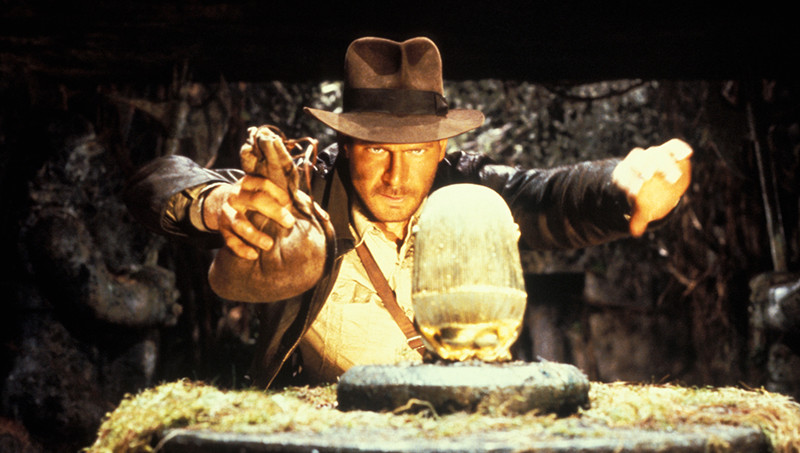
When Steven Spielberg and George Lucas set out to make a homage to the adventure serials of the 1930s while also creating a new cinematic icon they wanted to introduce said icon in the most impressive and thrilling way that was possible.
With the opening sequence of Raiders of the Lost Ark they did just that, introducing audiences across the world to Indiana Jones and setting a new standard for adventure movies for the rest of time.
It is almost a master class in how to build an entertaining scene, a step by step guide to perfection. First you have the dialogue that helps establish the nature of both characters and their competence in this field. Then there’s the slow build of tension, mixed in with the dry humour of Indy coming so painfully close to death in an instant and take it so wonderfully casually.
From creeping across the pressure pad littered floor to finally reaching the idol itself where Indy carefully guestimates the right weight to act as a substitute for the idol and all the while Alfred Molina’s yearning expression makes the idol seem even more tantalising.
This careful and delicate preparation, matched beautifully by John Williams’ score, makes it all the more hilarious and thrilling when chaos breaks out.
The short moment of silence that bridges the two is priceless as it dawns on both the characters and the audience that the whole plan has fallen apart. Then just when you think it’s all over Spielberg leaves the biggest set piece until last with the giant rolling boulder.
9. Prologue in Fanny and Alexander
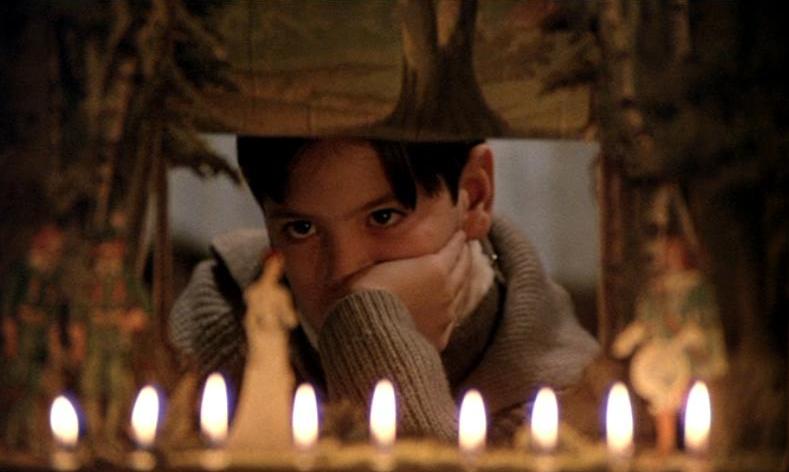
Over three hours of Sven Nykvist’s cinematography is a good enough reason to watch any movie and if you needed any further convincing then you only need to experience the prologue of Ingmar Bergman’s late masterpiece.
Partially based on Bergman’s own childhood experiences the film’s plot centres around two siblings and their large family in Uppsala, Sweden in the 1900s.
Where Bergman’s previous films dealt with the large and existential questions concerning the human condition such as death, sex and god, his 1982 film concerns itself more with the intimate details of life and that is perfectly reflected within its prologue.
A sweeping shot that goes down to a small toy box of a child that is captured as lovingly as the most sweeping and grand of landscapes.
As the child and the camera leave the room into the large house beyond it we get to witness even more stunningly photographed shots, each one as beautiful as the last.
There is a deep mysticism to the way in which it is all filmed, one of loving care and obsessive attention to detail. It is almost difficult to describe in writing so the only way one can really experience the scene and its beauty is simply to watch it.